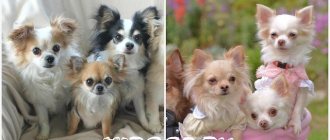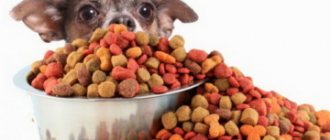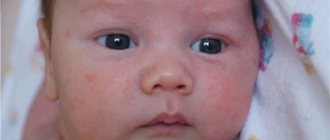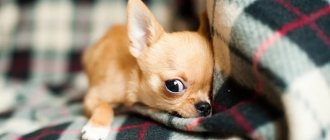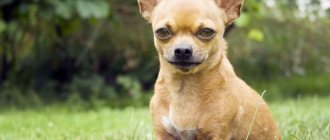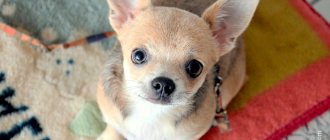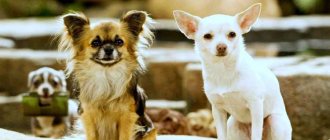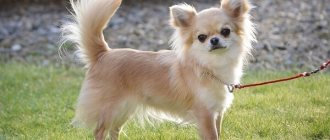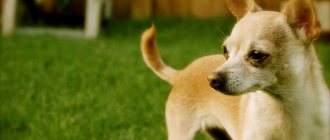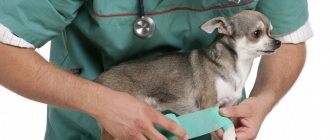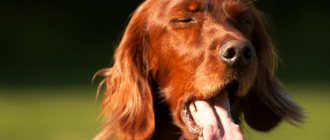The Chihuahua is a small, beautiful dog that is very popular today.
When purchasing such a dog, you need to keep in mind that there will be no less worries with him than with a large dog.
The breed is not suitable for everyone.
Therefore, it is important to be informed so that you do not have to be disappointed in the dog, because everyone dreams of finding a pet exactly to their liking.
Let's find out about everything in detail.
Brief history of origin
It is still not known for certain how exactly the Chihuahua breed appeared. It is only confirmed that it is of natural origin.
Most researchers agree that Chihuahuas originated in what is now Mexico. This is evidenced by wall paintings and excavation results.
The dogs were originally mute, they were called “techichi”. These were sacred animals that lived in the Taltec tribe.
There are also theories that they came from the Incas and Mayans.
One way or another, it was the Techichi that were the ancestors of modern Chihuahuas.
Breed standard and what purebred dogs look like
The international standard does not establish the parameters of the Chihuahua, but in 1954 the English Kennel Club developed indicators of weight, height, color, proportions and physique for the Chihuahua.
The name of the breed is given in honor of the Mexican state where the dog was discovered.
Chihuahua is the smallest breed in the world.
She is distinguished by her aristocratic behavior, she always walks with her head raised, her tail is slightly curled towards the lower back. It creates a semi-ring over the back.
The length of an adult dog should be a couple of centimeters less than the height at the withers..
An ideal representative of the breed should have a square body, height 30-38 cm, weight 1.5-4 kg.
The smallest representatives of Chihuahuas can weigh 500 g-1.5 kg:
- The dog's eyes should be round and protruding. A light iris is not an indicator of purebredness, only a dark one.
- The Chihuahua has large ears, wide at the base and tapering to the tip. In a calm state, they can fall, as they cease to be tense.
- An adult dog should have 12 incisors, 4 canines, 16 premolars, 10 molars, for a total of 42 teeth. An overshot or misaligned jaw is a defect.
- The chest should be broad but in proportion to the body, and the ribs should be rounded, not barrel-shaped. A healthy dog looks slim, but not too thin - the body should be athletic. The back is muscular, the croup is strong.
- The head should resemble an apple in shape. The Chihuahua is the only breed in which the fontanel does not overgrow. The dog's forehead is high, with prominent eyebrows. The cheekbones are rounded, the muzzle is short, the lips should completely cover the teeth. The nose is slightly snub, there is a crease between the eyes. Lips and cheeks are dry.
- The hind legs are developed slightly larger than the front ones - this is necessary for running and jumping. In general, all limbs are strong, designed for the dog to move freely. The gait is soft and active.
Treatment
If you are experiencing symptoms of chocolate poisoning or your dog has just ingested chocolate candy, you should call your veterinarian immediately. The toxicity of chocolate depends on the dog's size, age, breed and the amount of chocolate eaten. Alas, there is no specific antidote to treat chocolate poisoning. The veterinarian may use some supportive treatments to reduce the amount of theobromine in the body. He may put the dog on an IV to prevent dehydration due to vomiting and diarrhea, or induce excessive urination to rid the dog of theobromine. An emetic may help if given within 4 hours of eating the candy. If the period is longer than 4 hours and the dog continues to show signs of toxicity, then the doctor may use activated charcoal. Seizures in dogs are treated with special injections. Irregular or excessive heartbeat - heart medicine.
Humans can deal with theobromine effectively, but dogs cannot. If you love your little one, don't give her candy. I know how difficult it is to resist those pleading eyes. But, you should have a heart of stone when it comes to caring for an animal and avoid feeding your dog candy, rather prepare him dog cookies and enjoy the treats together. Make sure you explain to children why they shouldn't share their candy with their dog. Chocolate may be a guilty pleasure for humans, but for a dog it can lead to a lot of trouble.
Character and temperament
This dog is temperamental, cheerful, and resistant to stress if the owner is nearby. They have a quick reaction, and the dogs are also very hardy.
Their small size does not prevent them from being brave and fearless; Chihuahuas will defend their owner without hesitation.
Representatives of this breed are active, they are funny, not lazy, and they are energetic.
They are reserved towards strangers, very curious about new objects and unusual processes occurring in the house.
CAREFULLY!
Chihuahuas love to follow their owners and get underfoot, so you need to be careful not to step on the dog or trip over it.
These are also clean dogs, they wash themselves, and quickly get used to the tray or diaper. But extreme stress can cause them to urinate uncontrollably.
Breed standard
The first thing to talk about is a description of the breed. It complies with NKP standards.
- The size of the dog is miniature, the body is proportional. The male's body has proportions approaching a square. The dog should not go beyond the square that is mentally described around it.
- The body shape of bitches can be elongated. It is preferable that the body proportions are as close to square as possible.
- The shape of the skull is similar to that of an apple.
- On the muzzle there are large dark eyes.
- The not too thick tail of representatives of this breed is of medium length. Chihuahuas always curl the tip of their tail. Pets often bend their tail in the form of a half ring. The tip of the tail “looks” at the lower back.
- There are long-haired and short-haired representatives of the breed. Some say that long-haired Chihuahuas have a more flexible character. The breeders do not confirm this fact.
- The height at the withers does not exceed 23 cm. The lower limit is 15 cm. Weight varies between 0.5-3 kg. The ideal weight is 1.5-2.5 kg.
Chihuahuas grow on average up to 7 months. At 5-6 months it becomes clear how tall the puppy will grow.
The last point in the description of the breed concerns how long Chihuahuas live. Their average life expectancy is 16 years. With proper care, a Chihuahua can live 18-20 years.
Some breeders offer tikup Chihuahuas to buyers. Due to the abnormally small size of the animal, they are asking an inflated price. But the reasons why dogs weigh less than 500 g are diseases or malnutrition.
Types of Chihuahua
There are two varieties of Chihuahua: Cobby and Deer. It is not difficult to distinguish these representatives of the breed. The first ones are stocky and squat, have a bushy tail, small ears, dense and long hair. Representatives of the dir variety are taller, have large ears, thin paws and cannot boast of thick hair.
The cobby variety is sometimes spelled with one letter "b" (cobi). This is incorrect because the name comes from the word "cobby", which means "stocky".
Popular types
Like almost every breed, Chihuahuas also have their own species. They are classified by physical consistency and length of coat.
Types of Chihuahuas
by body type, list :
- Cobby . These dogs are denser and stockier. They have a large head compared to their body and large eyes. The dogs have large ears at the base, a voluminous chest, muscular legs and a powerful tail. Cobbies also have an undercoat.
- Dir. This type of Chihuahua looks a little like a fawn. They have a small head, proportional to the body, and large, bat-like ears. The chest is smaller than that of a cobby, the legs are longer and thinner. There is practically no undercoat. Unlike cobbies, they move not with powerful pushes, but with small and frequent steps.
Types of Chihuahuas by coat length (shown in the photo):
- Short-haired or smooth-haired Chihuahuas . Their fur lies tightly to the body, is shiny and soft to the touch. Longer fur can only be found on the neck and tail. There is no undercoat.
- Long-haired Chihuahuas. The fur coat is thin and soft. The fur accumulates most on the chest and tail; on the ears it looks like a brush. On the body itself, the fur should not be particularly long.
Breeders give preference to such Chihuahua colors as white, cream, chocolate, sable, black and white, wolf and red.
Main types of colors
The most common colors are:
- Ginger . A gradation from red to light red fur is acceptable. It is almost impossible to meet a completely red dog. It goes with other colors. These may be white spots. “Red sable” suggests hairs with dark tips (shown in the picture).
- Black. All-black Chihuahuas are just as rare as red ones. Most often, a dog is born black and tan. There are also black Chihuahuas with white markings on the chest and toes. Black and tan Chihuahuas with milky spots on the chest, legs and tip of the tail are popular.
Rare colors of Chihuahua (shown in the photo):
- Chocolate. Brown dog with a red tint. Dogs come in pure color, or also with small light markings. Various shades of chocolate, sable, and chocolate tricolor are allowed.
- White. Found only in its pure form. There should be no large marks or stains on the fur.
- Brindle . This color allows for a large number of variations. For a Chihuahua, this is fawn in any gradation, thick black. Different types of patterns on wool are acceptable.
- Lilac. A very beautiful color that is quite rare. The shade can be of any saturation. When the color is so light that it looks like pink, it is called “Isabella.” A purple tricolor is allowed.
- Blue. The blue Chihuahua can be dark, almost gray, or smoky. White patches on wool and tricolor are allowed.
Prohibited color of Chihuahua:
- Merle, or marble. The wool looks as if it is unevenly dyed black, dark gray or beige, which is why the marbled effect is created. The eye color of these dogs is watery blue. Puppies with this color are often born blind, deaf, or without eyes or ears at all. Often offspring with such a gene die in the womb or at birth. If the individual grows, its sterility may be revealed.
Experts believe that this gene appeared in Chihuahuas from crossing with dachshunds, which are carriers, since it does not harm their health.
Rare colors of Chihuahua
Rare Chihuahua colors include chocolate, white, brindle, lilac (lilac) and blue. They, like common colors, can have a huge number of combinations. Let's look at the most famous ones.
Chocolate implies brown fur with a warm reddish tint (the pads on the paws and nose should also be brown). It can be clean or with small marks on the paws and chest. The “sable” type has a chocolate base color, the rest is like a red sable. At the same time, small milky inclusions are unacceptable: white should either be expressed in clear spots (can be on the head, chest, tail and paws), or it should not be there at all. “Sable” can also be chocolate-red: a light chocolate shade with the same dark stripe from head to tail. There is a tan color option with lightened areas. The chocolate tricolor looks interesting: a predominantly white body (in some cases there may be brown specks on it - the so-called specks) with a chocolate-colored cloak and light red tan.
The white color of the Chihuahua is also found in its pure form. In this case there should be no marks or specks. This coat color is complemented by pink skin, black or brown nose and claws.
Often white serves as a “background” for other colors. There may be large red, gold and chocolate spots. Individuals with cream-colored markings look elegant. Spectacular graphics are inherent in individuals of the black and white type.
There are a lot of variations here. In Chihuahuas, the brindle color is considered to be either fawn of any gradation or thick black. The brindle coloring allows for many types of patterns, for example, light fawn with black stripes or deep black diluted with fawn and tan. You can also find a dog whose white “base” is painted with tiger spots located on the head and/or body.
A beautiful and rare variety. There may be different saturation options. This Chihuahua's fur can be so light purple in color that it literally looks pink (called an Isabella). A dark purple coat type is also possible. White tips on the paws and small spots on the chest are allowed (tan type). Lilac allows options with large white spots on the main background (can be located anywhere except on the sides and back) or, conversely, purple spots with a main white background. A lilac tricolor is possible. A long-haired individual of this type looks especially impressive.
The blue Chihuahua can be either a rather dark gray color or a very delicate, smoky color. There are variants of blue color with white splashes on the chest and tips of the paws; large, clearly defined white spots on a blue background are acceptable, and vice versa. The blue and white variety is sometimes decorated with specks. This type has a beautiful tricolor: a blue cloak on a white body with light red tan.
Unusual Chihuahuas
Sometimes genes adjust the coat color of dogs in very funny ways, resulting in funny and unusual Chihuahuas. This is a Chihuahua, popular on the Internet, with eyebrows similar to human ones.
It is not uncommon for Chihuahua puppies with spots on their fur that take on the shape of a heart, and this feature is often inherited from one of the parents .
The owner of a Chihuahua shared a photo of his pet, where one of the spots resembled the continent of Eurasia.
Price
Let's figure out how much a Chihuahua from a nursery costs. For a purebred puppy you will have to pay from 15 to 100 thousand rubles. Many factors influence pricing. For a girl who will give birth in the future, you will have to pay more money than for a boy. The difference is sometimes 30-35%.
The price of a Chihuahua puppy also depends on its weight. The smaller the representative of the breed, the more valuable it is, so large puppies, which, when mature, will weigh more than 1.5 kg, are cheaper. The price for miniature ones is much higher.
Color is another factor that affects cost. A Chihuahua puppy of a standard color is cheaper than a representative of the breed with a rare coat color.
The pricing policy is also influenced by the constitution of the dog. Representatives with a strong build and low paws are valued more.
Less important factors influencing pricing
The price also depends on where you buy the puppy. There are elite nurseries that sell puppies at quite high prices. At the same time, they provide documents confirming the purity of the breed. When purchasing a four-legged friend from an elite nursery, you can be sure that the puppy is healthy. In nurseries where specialists are involved in breeding, healthy dogs with good heredity are crossed.
Some people buy puppies secondhand for the reason that it is cheaper. But you will not be able to find out which dogs were used during mating. Accordingly, be prepared for the fact that you may not get the type of dog you expected. Behavior that is atypical for a Chihuahua and deviations from the standard are the result of purchasing a pet from advertisements.
Offspring from titled dogs are more expensive, but the character of a Chihuahua does not depend on titles, color or constitution.
What do boys and girls look like and how do they differ?
Female Chihuahuas are slightly larger than males, which is why they are more successful in shows.
Males have a square shape, while females have a more elongated body, which is associated with their reproductive functions.
Girls also have a more graceful and thin neck.
Dogs also differ in temperament . Females are calmer, balanced and peace-loving, but aggressive in terms of protecting their offspring, and can be angry. Males are hot-tempered, active, the first to get into fights, and less well trained.
What puppies look like
Puppies are very different from adults, but they grow quickly, and at the age of three months they already resemble ordinary Chihuahuas.
They are born very small . Due to the size of the mother, complications often occur during childbirth, when the help of a specialist cannot be avoided.
Dogs are born blind and very tiny. They can only crawl in order to find mother's milk.
At birth, the color of the babies is already visible, and in most cases it does not change, but remains . The puppies' ears are not yet erect, they are pressed to the head, the tail is short and thin, pressed to the body.
The dogs still have a pink nose, their claws are small and soft, they cannot yet be scratched - this is necessary so that they can stimulate the supply of milk while eating.
The puppies don't have whiskers yet, they will appear later.
How to choose a pet
Do not buy a puppy on the market, it is better to contact a professional breeder . Before doing this, find people who have already dealt with it, ask their opinion. This way you can know in advance what to expect when you go pick up your puppy.
IMPORTANT!
Pay attention to the conditions in which the dogs are kept, look at what food the puppies eat.
You should have no doubt that the puppy before you was in good hands.
Ask the breeder for the dog's passport, ask how many puppies were in the litter - there should be no more than five.
Also, when purchasing, you should pay attention to:
- Appearance of a puppy. It should not look sick or dirty. Shouldn't be either thin or fat. Also check whether his appearance meets the standard, there are no deviations, lameness, or lethargy. Check your nose - it should be cold and slightly moist. There should be no discharge in the eyes and ears. The ears should not lie down during the game, they should be tense. The coat should be soft and shiny. Check to see if your puppy has skin rashes, ringworm, fleas or ticks. The upper jaw should completely cover the lower jaw.
- Chihuahua behavior. Observe your puppy while he plays. He should be active, cheerful, and not aggressive. Talk to him yourself, see if there is any excessive nervousness or fear in him. Chihuahuas are always curious, so if he boldly comes to sniff your hands, it's a good sign. Wait until lunch time. If the puppy eats with appetite and eats the entire bowl, that’s also good.
Choosing a puppy
If you take a miniature dog to participate in exhibitions, then preference should be given to the smallest representative from the entire litter. To understand how big a puppy will grow, just look at his dad. Very rarely do puppies exceed the head of the family in size.
You should also be prepared for the fact that it is not you who choose the puppy, but the puppy who chooses you. If the baby comes into her own hands, she should be taken home.
If we talk about the exhibition version, it would not be amiss to familiarize yourself with the pedigree. If you are taking a puppy for the hobby, then you don’t have to pay much attention to the dimensions and pedigree.
As for health, it is important to choose carefully: find out whether the parents of the children have diseases or allergies. If any are present, then most likely they will be passed on to the offspring. The presence of fleas is unacceptable. It is worth paying attention to the cleanliness of your eyes and ears.
